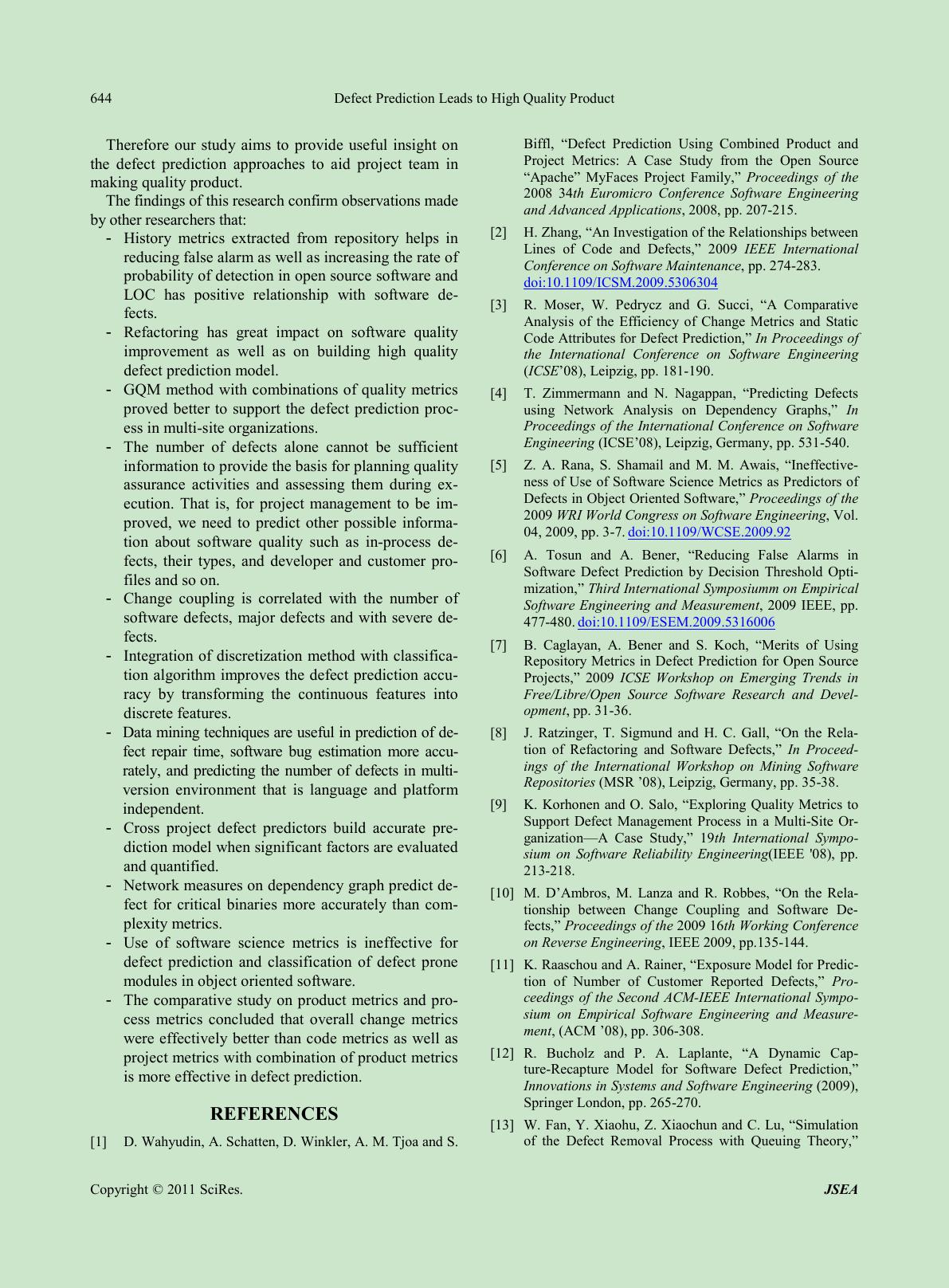
Defect Predict ion Leads to High Quality Product
Copyright © 2011 SciRes. JS EA
Therefore our study aims to provide useful insight on
the defect prediction approaches to aid project team in
making quality product.
The findings of this research confirm observations made
by other researchers that:
- History metrics extracted from repository helps in
reducing false alarm as well as increasing the rate of
probability of detection in open source software and
LOC has positive relationship with software de-
fects.
- Refactoring has great impact on software quality
improvement as well as on building high quality
defect prediction model.
- GQM method with combinations of quality metrics
proved better to support the defect prediction proc-
ess in multi-site organization s.
- The number of defects alone cannot be sufficient
information to provide the basis for planning quality
assurance activities and assessing them during ex-
ecution. That is, for project management to be im-
proved, we need to predict other possible informa-
tion about software quality such as in-process de-
fects, their types, and developer and customer pro-
files and so on.
- Change coupling is correlated with the number of
software defects, major defects and with severe de-
fects.
- Integration of discretization method with classifica-
tion algorithm improves the defect prediction accu-
racy by transforming the continuous features into
discrete features.
- Data mining techniques are use ful in prediction of de-
fec t repair time, software bug estimation more accu-
rately, and predicting the number of defects in mult i-
version environment that is language and platform
independent.
- Cross project defect predictors build accurate pre-
diction model when signi fican t factor s are evaluated
and quantified.
- Network measures on dependency graph predict de-
fect for critical binaries more accurately than com-
plexity metrics.
- Use of software science metrics is ineffective for
defect prediction and classification of defect prone
modules in object oriented software.
- The comparative study on product metrics and pro-
cess metrics concluded that overall change metrics
were effectively better than code metrics as well as
project metr ics with co mbination of pr oduct metrics
is more effective in defect prediction.
REFERENCES
[1] D. Wahyudin, A. Schatten, D. Winkl er , A. M. Tjoa and S.
Biffl, “Defect Prediction Using Combined Product and
Project Metrics: A Case Study from the Open Source
“Apache” MyFaces Project Family,” Proceedings of the
2008 34th Euromicro Conference Software Engineering
and Advanced Applications, 2008, pp. 207-215.
[2] H. Zhang, “An Investigation of the Relationships between
Lines of Code and Defects,” 2009 IEEE International
Conference on Software Maintenance, pp. 274-283.
doi:10.1109 /I C S M. 20 09.53 06 304
[3] R. Moser, W. Pedrycz and G. Succi, “A Comparative
Analysis of the Efficiency of Change Metrics and Static
Code Attributes for Defect Prediction,” In Proceedings of
the International Conference on Software Engineering
(ICSE’08 ), Leipzig, pp. 181-190.
[4] T. Zimmermann and N. Nagappan, “Predicting Defects
using Network Analysis on Dependency Graphs,” In
Proceedings of the International Conference on Software
Engineering (ICSE’08), Leipzig, Germany, pp. 531-540.
[5] Z. A. Rana, S. Shamail and M. M. Awais, “Ineffective-
ness of Use of Software Science Metrics as Predictors of
Defects in Ob ject Orien ted Software,” Proceedings of the
2009 WRI World Congress on Software Engineering, Vol.
04, 2009, pp. 3-7. doi : 10.1109/WCSE.2009.92
[6] A. Tosun and A. Bener, “Reducing False Alarms in
Software Defect Prediction by Decision Threshold Opti-
mization,” Third International Symposiumm on Empirical
Software Engineering and Measurement, 2009 IEEE, pp.
477-480. doi:10.1109 / E S EM . 20 09.53 16 006
[7] B. Cagl ayan, A. Bener and S. Koch, “Merits of Using
Repository Metrics in Defect Prediction for Open Source
Proj ects,” 2009 ICSE Workshop on Emerging Trends in
Free/Libre/Open Source Software Research and Devel-
opment, pp. 31-36.
[8] J. Ratzinger, T. Sigmund and H. C. Gall, “On the Rela-
tion of Refactoring and Software Defects,” In Proceed-
ings of the International Workshop on Mining Software
Repositories (MSR ’08), Leipzig, Germany, pp. 35-38.
[9] K. Korhonen and O. Salo, “Exploring Quality Metrics to
Support Defect Management Process in a Multi-Site Or-
ganization—A Case Study,” 19th International Sympo-
sium on Software Reliability Engineering(IEEE '08), pp.
213-218.
[10] M. D’Ambros, M. Lanza and R. Robbes, “On the Rela-
tionship between Change Coupling and Software De-
fec ts,” Proceedings of the 2009 16t h Worki ng Con ference
on R evers e Engineer ing, IEEE 2009, pp.135-144.
[11] K. Raaschou and A. Rainer, “Exposure Model for Predic-
tion of Number of Customer Reported Defects,” Pro-
ceedings of the Second ACM-IEEE International Sympo-
sium on Empirical Software Engineering and Measure-
ment, (ACM ’08), pp. 306-308.
[12] R. Bucholz and P. A. Laplante, “A Dynamic Cap-
ture-Recapture Model for Software Defect Prediction,”
Innovations in Systems and Software Engineering (2009),
Spring e r L on don, pp. 265-270.
[13] W. Fan, Y. Xiaohu, Z. Xiaochun and C. Lu, “Simulation
of the Defect Removal Process with Queuing Theory,”